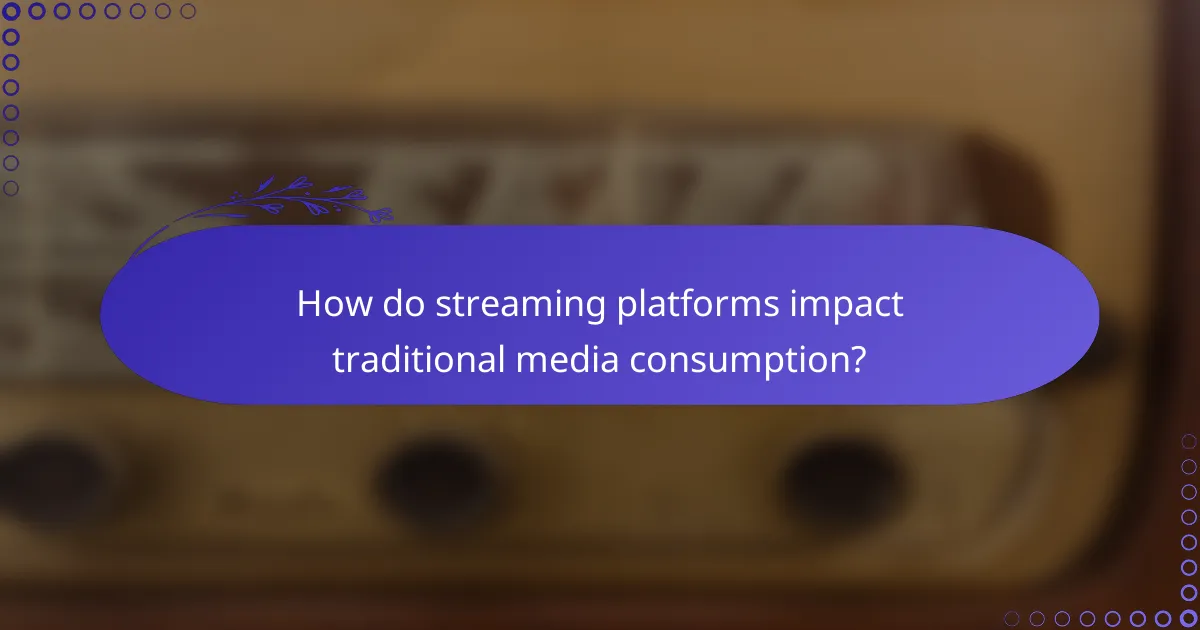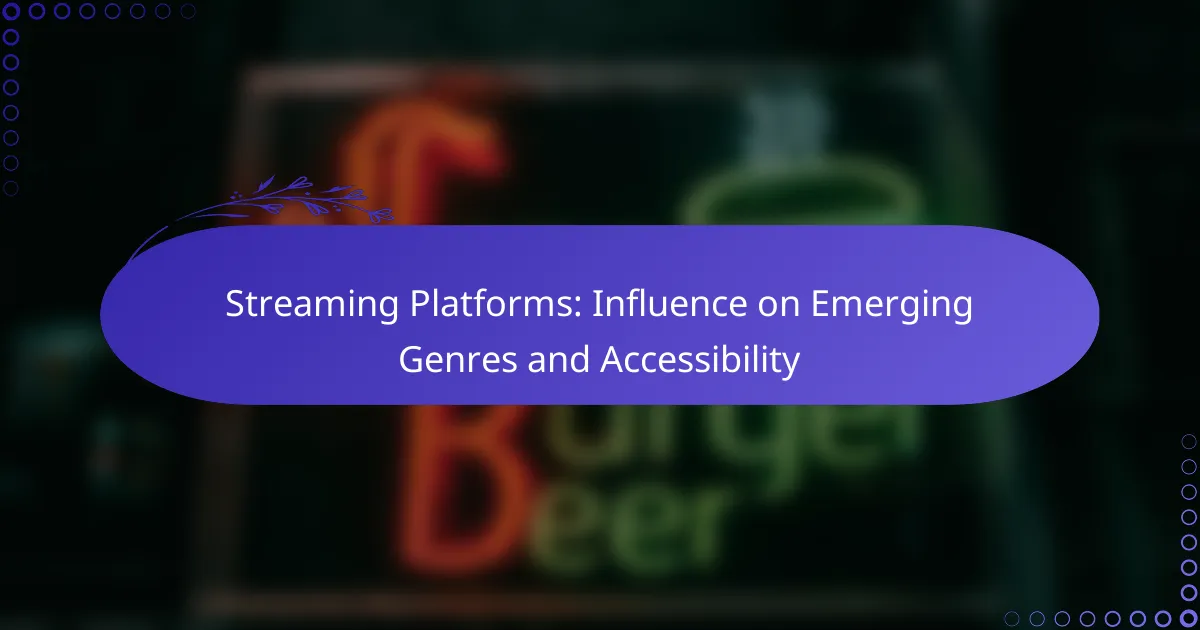Streaming platforms have transformed the landscape of entertainment by promoting emerging genres and fostering innovation in storytelling. By offering diverse content that often goes unnoticed by traditional media, these platforms empower creators to reach broader audiences. Additionally, they enhance accessibility through features like closed captioning and audio descriptions, ensuring that all viewers can enjoy a more inclusive viewing experience.

How do streaming platforms influence emerging genres in the US?
Streaming platforms significantly shape emerging genres in the US by providing a space for diverse content that traditional media often overlooks. They enable creators to reach wider audiences, fostering innovation and experimentation in storytelling.
Increased visibility for niche genres
Streaming services have democratized access to content, allowing niche genres to gain visibility that was previously unattainable. For example, genres like anime, indie horror, and foreign films can now find dedicated audiences, leading to increased production and investment in these areas.
This visibility often translates into a broader acceptance of diverse storytelling styles, as platforms curate content to cater to specific viewer interests. As a result, genres that once struggled for recognition can now thrive and evolve.
Collaboration with independent creators
Many streaming platforms actively seek partnerships with independent creators, providing them with resources and funding that can help bring unique stories to life. This collaboration often results in innovative content that challenges conventional narratives and attracts diverse audiences.
For instance, platforms may offer production support or marketing assistance, enabling independent filmmakers to reach larger audiences without the constraints of traditional distribution channels. This trend not only enriches the content landscape but also encourages a more varied representation of voices and experiences in media.

What are the accessibility features of major streaming platforms?
Major streaming platforms offer various accessibility features to enhance viewing experiences for all users, including closed captioning, subtitles, and audio descriptions. These features ensure that content is more inclusive for individuals with hearing or visual impairments.
Closed captioning and subtitles
Closed captioning and subtitles are essential tools for making video content accessible to those who are deaf or hard of hearing. Closed captions provide a text representation of spoken dialogue and relevant sound effects, while subtitles typically translate spoken language into another language without sound descriptions.
Most platforms, such as Netflix and Amazon Prime Video, allow users to enable or disable these features easily through their settings. It’s important to check the availability of these options for specific shows or movies, as not all content may have them.
Audio descriptions for visually impaired
Audio descriptions provide an additional audio track that narrates visual elements of a program, making it accessible for visually impaired viewers. This feature describes actions, settings, and other visual cues during natural pauses in dialogue, enhancing understanding of the content.
Streaming services like Disney+ and Hulu offer audio descriptions for a significant portion of their library. Users can activate this feature in the audio settings, but availability may vary by title, so it’s advisable to look for the audio description option when selecting content.

How do streaming platforms affect content diversity?
Streaming platforms significantly enhance content diversity by providing a wider range of genres and voices that might not find a place in traditional media. They enable creators from various backgrounds to share their stories, leading to a richer tapestry of narratives and perspectives.
Broadening representation in storytelling
Streaming services have made strides in broadening representation by featuring stories from underrepresented communities. This includes narratives centered around different ethnicities, genders, and sexual orientations, which were often marginalized in mainstream media.
For example, shows like “Pose” and “Master of None” highlight [censured] experiences and cultural diversity, respectively. Such content not only entertains but also fosters understanding and empathy among viewers.
Showcasing international content
Streaming platforms have become gateways for international content, allowing viewers to access films and series from around the globe. This exposure to foreign languages and cultures enriches the viewing experience and promotes global storytelling.
Popular platforms like Netflix and Amazon Prime Video invest in local productions, such as “Money Heist” from Spain and “Lupin” from France, which have gained international acclaim. This trend encourages cultural exchange and broadens audiences’ horizons beyond their local narratives.

What are the challenges of accessibility on streaming platforms?
Accessibility on streaming platforms faces several challenges, primarily due to inconsistent feature availability and technical barriers that hinder user experience. These issues can limit access for individuals with disabilities or those using different devices and internet connections.
Inconsistent availability of features
Many streaming platforms offer varying levels of accessibility features such as closed captions, audio descriptions, and screen reader compatibility. This inconsistency can create confusion and frustration for users who rely on these tools to enjoy content fully.
For example, while some platforms may provide comprehensive subtitle options in multiple languages, others might only offer basic captions or none at all. Users should check the accessibility features of a platform before subscribing to ensure it meets their needs.
Technical barriers for users
Technical barriers can significantly impact accessibility on streaming platforms. Users may encounter issues such as slow internet speeds, outdated devices, or incompatible software that prevent them from accessing content seamlessly.
To mitigate these challenges, users should ensure their devices are updated and compatible with the latest streaming technologies. Additionally, using a reliable internet connection can enhance the viewing experience, reducing buffering and improving overall accessibility.

How do user preferences shape genre development on streaming platforms?
User preferences significantly influence genre development on streaming platforms by guiding content creation and curation. As viewers engage with specific genres, platforms analyze this data to promote similar content, ultimately shaping the types of genres that gain popularity.
Data-driven content recommendations
Streaming platforms utilize algorithms to analyze user behavior, including viewing history and ratings, to generate personalized content recommendations. This data-driven approach allows platforms to identify trending genres and tailor their offerings accordingly, ensuring that users are exposed to content that aligns with their interests.
For instance, if a significant number of users watch a particular genre, such as sci-fi, platforms may invest more in producing similar content or acquiring rights to popular titles within that genre. This feedback loop not only enhances user satisfaction but also drives the evolution of genre trends.
Influence of viewer demographics
Viewer demographics, such as age, location, and cultural background, play a crucial role in shaping genre preferences on streaming platforms. Different age groups may gravitate towards distinct genres, leading platforms to cater their content libraries to these varying tastes.
For example, younger audiences might prefer genres like fantasy or teen dramas, while older viewers may lean towards classic films or documentaries. By analyzing demographic data, streaming services can strategically develop and promote genres that resonate with their target audiences, ensuring a diverse and appealing content selection.

What are the key criteria for selecting a streaming platform?
When selecting a streaming platform, consider factors like content library size, subscription costs, and available plans. These criteria can significantly influence your viewing experience and budget.
Content library size and variety
The size and variety of a streaming platform’s content library are crucial for ensuring you have access to a wide range of shows and movies. Look for platforms that offer a mix of genres, including popular titles, original content, and niche offerings.
Some platforms may focus on specific genres, such as documentaries or independent films, while others provide a more extensive selection across multiple categories. Assess your viewing preferences to find a service that aligns with your interests.
Subscription costs and plans
Subscription costs vary widely among streaming platforms, typically ranging from around $5 to $15 per month. Many services offer different plans, including ad-supported options at lower prices and premium tiers with additional features.
Consider your budget and how often you plan to use the service. Some platforms may also provide free trials, allowing you to explore their offerings before committing to a subscription. Be cautious of hidden fees or automatic renewals that could impact your overall costs.

How do streaming platforms impact traditional media consumption?
Streaming platforms significantly alter traditional media consumption by providing on-demand access to a vast array of content, which leads to changing viewer habits and preferences. As audiences shift towards these platforms, traditional media outlets face challenges in retaining viewership and adapting to new consumption patterns.
Decline in cable subscriptions
The rise of streaming services has contributed to a notable decline in cable subscriptions, with many consumers opting for more flexible, cost-effective alternatives. Reports indicate that millions of households have cut the cord, favoring platforms like Netflix, Hulu, and Amazon Prime Video for their diverse offerings and lower monthly fees.
This decline prompts traditional cable providers to rethink their business models, often leading to bundled services or the introduction of their own streaming options. For example, many cable companies now offer streaming packages that mimic the on-demand nature of popular platforms to retain subscribers.
Shift in advertising strategies
As streaming platforms gain traction, advertisers are adjusting their strategies to reach audiences effectively. Traditional media often relies on commercial breaks, while streaming services frequently utilize targeted ads based on user data, allowing for more personalized marketing efforts.
This shift means that advertisers must consider where their target demographics are spending their time. For instance, younger audiences may be more engaged with content on platforms like TikTok or YouTube, prompting brands to allocate budgets accordingly. Additionally, some streaming services offer ad-free subscription tiers, which can complicate advertising strategies further.

What emerging trends are shaping the future of streaming platforms?
Emerging trends such as the integration of virtual reality experiences and the expansion of interactive storytelling are significantly influencing the future of streaming platforms. These innovations enhance user engagement and create more immersive viewing experiences, catering to diverse audience preferences.
Integration of virtual reality experiences
The integration of virtual reality (VR) experiences into streaming platforms allows viewers to engage with content in a more immersive way. Users can don VR headsets to enter virtual environments, making them feel as if they are part of the story. This trend is particularly popular in gaming and live events, where the experience can be enhanced by 360-degree views.
Platforms like Oculus TV and YouTube VR are leading the charge, offering a range of content that includes concerts, documentaries, and interactive films. As VR technology becomes more affordable, expect a wider adoption among mainstream streaming services, which may require users to invest in compatible hardware.
Expansion of interactive storytelling
Interactive storytelling is gaining traction on streaming platforms, allowing viewers to make choices that influence the narrative. This format creates a unique viewing experience where the audience can engage with the story actively rather than passively. Popular examples include Netflix’s “Bandersnatch” and various interactive children’s shows.
To successfully implement interactive storytelling, platforms must ensure seamless navigation and a user-friendly interface. Content creators should focus on crafting compelling narratives that adapt to user choices without compromising story quality. As this trend grows, expect more platforms to explore interactive formats, potentially leading to subscription models that cater specifically to interactive content.
